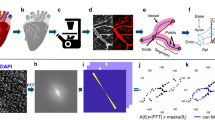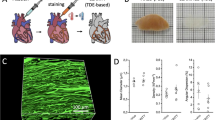Summary
To study myocardial vascular development, stereological parameters were estimated in 24 Wistar rat hearts of six different age groups, from newborn to adult. The vascular surface density showed a sharp increase in the first 2 weeks, a peak around the age of 2 weeks, and then a steady decrease until it flattened in adulthood. In contrast, the vascular volume percentage, when plotted against age, decreased continuously with the greatest change in the first week, after which the curve flattened. These findings are compatible with an increase in the number of capillaries with a concomitant decrease of their diameters. Qualitative scrutiny of the histology did indeed support the idea that vessels become thinner. Reconstructions of the histological sections showed the same change three dimensionally. The reconstructions also demonstrated very small holes that seemed to go through the capillaries in the younger stages. Corrosion casts of the blood vessels were made using a casting resin. This was injected into the umbilical artery of rat embryos from 15 days gestation to birth. In postnatal rats of six age groups methacrylate was injected directly into the left ventricle. These casts supported the stereological data by showing an increase in number and decrease in diameter of capillaries, while during pre- and postnatal development, the intervascular spaces lengthened from small, irregular spaces to long, rectangular ones. Small holes, the probable precursors of such spaces, were clearly visible in the wider vessels of the youngest stages. All data point to an interesting mode of capillary growth, i.e. growth by division of existing vessels.
Similar content being viewed by others
References
Anversa P, Olivetti G, Loud AV (1980) Morphometric study of early postnatal development in the left and right ventricular myocardium of the rat. I. Hypertrophy, hyperplasia, and binucleation of myocytes. Circ Res 46:495–502
Anversa P, Ricci R, Olivetti G (1986) Quantitative structural analysis of the myocardium during physiologic growth and induced cardiac hypertrophy: A review. J Am Coll Cardiol 7:1140–1149
Anversa P, Ricci R, Olivetti G (1987) Effects of exercise on the capillary vasculature of the rat heart. Circulation 75:I-12-18
Anversa P, Capasso JM, Ricci R, Sonnenblick EH, Olivetti G (1989) Morphometric analysis of coronary capillaries during physiologic myocardial growth and induced cardiac hypertrophy: a review. Int J Microcirc Clin Exp 8:353–363
Bogers AJJC, Gittenberger-de Groot AC, Dubbeldam JA, Huysmans HA (1988) The inadequacy of existing theories on development of the proximal coronary arteries and their connections with the arterial trunks. Int J Cardiol 20:117–123
Burri PH, Tarek MR (1990) A novel mechanism of capillary growth in the rat pulmonary microcirculation. Anat Rec 228:35–45
Burton GJ, Palmer ME (1989) The chorio-allantoic capillary plexus of the chicken egg: a microvascular corrosion casting study. Scanning Microsc 3:549–559
Caduff JH, Fisher LC, Burri PH (1986) Scanning electron microscope study of the developing microvasculature in the postnatal rat lung. Anat Rec 216:154–164
Canham PB, Potter RF, Woo D (1984) Geometric accommodation between the dimensions of erythrocytes and the calibre of heart and muscle capillaries in the rat. J Physiol (Lond) 347:697–712
Federspiel WJ, Popel AS (1986) Theoretical analysis of the effect of the particulate nature of blood on oxygen release in capillaries. Microvasc Res 32:164–189
Gundersen HJG, Bendtsen TF, Korbo L, Marcussen N, Møller A, Nielsen K, Nyengaard JR, Pakkenberg B, Sorensen FB, Vesterby A, West MJ (1988) Some new simple and efficient stereological methods and their use in pathological research and diagnosis. APMIS 96:379–394
Karnovsky MJ (1965) A formaldehyde fixative of high osmolarity for use in electron microscopy. J Cell Biol 27:137A
Kayar SR, Conley KE, Claassen H, Hoppeler H (1986) Capillarity and mitochondrial distribution in rat myocardium following exercise training. J Exp Biol 120:189–199
Litchfield JB (1958) Blood pressure in infant rats. Physiol Zool 31:1–6
Nakazawa M, Miyagawa S, Ohno T, Miura S, Takao A (1988) Developmental hemodynamic changes in rat embryos at 11 to 15 days of gestation, normal data of blood pressure and the effect of caffeine compared to data from chick embryo. Pediatr Res 23:200–205
Olivetti G, Anversa P, Loud AV (1980) Morphometric study of early postnatal development in the left and right ventricular myocardium of the rat. II. Tissue composition, capillary growth, and sarcoplasmic alterations. Circ Res 46:503–512
Olivetti G, Lagrasta C, Quaini F, Ricci R, Moccia G, Capasso JM, Anversa P (1989) Capillary growth in anemia induced ventricular wall remodeling in the rat heart. Circ Res 65:1182–1192
Ostadal B, Schiebler TH, Rychter Z (1975) Relations between the development of the capillary wall and myoarchitecture of the rat heart. Adv Exp Med Biol 53:375–388
Rakusan K, Turek Z (1985) Protamine inhibits capillary formation in growing rat hearts. Circ Res 57:393–398
Roberts JT, Wearn JT, Boten I (1941) Quantitative changes in the capillary-muscle relationship in human hearts during normal growth and hypertrophy. Am Heart J 21:617–633
Secomb TW (1987) Flow-dependent rheological properties of blood in capillaries. Microvasc Res 34:46–58
Tinkelenberg J (1979) Graphic reconstruction, microanatomy with a pencil. Audiovis Media Med 2:102–106
Tomanek RJ, Schalk KA, Marcus ML, Harrison DG (1989) Coronary angiogenesis during long term hypertension and left ventricular hypertrophy in dogs. Circ Res 65:352–359
Virágh S, Challice CE (1981) The origin of the epicardium and the embryonic myocardial circulation in the mouse. Anat Rec 201:157–168
Wenink ACG, Chon Y (1984) The value of graphic reconstrutions — comparison with scanning electron microscopy. Anat Rec 210:537–540
Zak R (1981) Contractile function as a determinant of muscle growth. In: Douben RM, Shay JW (eds) Cell and Muscle Motility 1. Plenum Press, New York, pp 1–33
Author information
Authors and Affiliations
Rights and permissions
About this article
Cite this article
van Groningen, J.P., Wenink, A.C.G. & Testers, L.H.M. Myocardial capillaries: Increase in number by splitting of existing vessels. Anat Embryol 184, 65–70 (1991). https://doi.org/10.1007/BF01744262
Accepted:
Issue Date:
DOI: https://doi.org/10.1007/BF01744262




